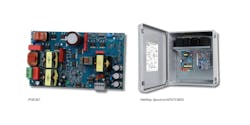Technology continues to reshape the security industry, enabling the deployment of an increasing number of wireless solutions and systems. Why use wireless? Here are a few scenarios.
1. When it is difficult to install wiring. This can be because of site conditions. Wireless is a valuable tool if elements of the system are separated by roads or mountains or other barriers which prohibit wiring.
2. When the project is only a temporary deployment.
3. Sometimes your application will require portability, where a device cannot be tethered, and must be mobile.
4. Installing wire would be too disruptive. Occasionally you will encounter a scenario where wiring is feasible, but the time it will take to perform, or the inconvenience it will cause the client, makes a wireless alternative more attractive even if it is not less expensive.
The evolution or perhaps more accurately the revolution of wireless has occurred in a remarkably brief time period, with advances spiking the curve most in the last few years.
When I first entered the security industry, wireless equipment for commercial security was limited and largely still in the ‘novelty’ phase of development. Many security professionals refused to use it.
But wireless was used for wireless garage door controls which used large batteries and had only a limited number of unique channels and frequencies. The technology was so bad that it was common to get callbacks because doors would be opening by themselves, due to equipment nearby programmed to the same settings. It was also pretty well common knowledge that any minor league geek could put together a device which would scroll through all the possible channels form a car parked in front of the target premises.
Wireless burglar alarms were also still new and not perfected. Again battery life and reliability plagued early wireless security.
High end wireless equipment was expensive and transmitters and receivers weighed a ton due to the battery pack and were about the size of a suitcase.
Today’s selection of wireless is dramatically improved. The engineers have increased range and reliability, reduced power consumption (extended battery life); are using the frequency spectrum more efficiently, and reduced the size of the components, allowing miniaturization of the hardware.
We’re using radio controls for door releases and handicapped door operator applications. Programming which once involved setting dipswitches is now replaced with smart devices which program themselves. The transmitters and receivers are small and quite easy to deploy.
Wireless transmitters for door control systems are favored over hard-wired for a few good reasons. First, they are less expensive to install because wire and the labor to install the wire is eliminated.
Another reason is the transmitters can be strategically placed, or even carried by individuals. In an office this means the door control system can be operated from wherever the person with the transmitter is at the moment. Also the transmitters can be locked away when not in use.
Multiple button transmitters and multiple channel receivers allow complex functionality, such as sequenced doors and mantraps to be easily achieved.
Wireless alarms are now the standard, and the technology has earned Agency Listings and Approvals for even the highest security applications. Transmitters are tiny and easy to conceal, battery life is extraordinary, and transmitters and receivers are fully supervised for signal integrity and battery level.
Alarm reporting and central station connections have also made the transition, where hard-wired dial-up land lines are being supplanted by cellular and RF (Radio Frequency) alternatives.
TECHNOLOGIES
The term “Wireless“ can describe several different technologies. Line of Sight refers to High Frequency technologies which can use high frequency RF and infrared (IR) light modulation.
Wireless can also be used to refer to technologies which are not ‘wireless’ but provide the cost advantages of wireless technologies because they do not require additional or dedicated wiring for deployment. Two such technologies are PoE and PLC.
PoE refers to Power over Ethernet, and refers to network appliances which use the same network topology to transmit both the data as well as the power. This technology is limited to hard-wired (Ethernet) networks. A growing number of video surveillance and access control products offer this feature.
PLC refers to power line carrier technologies which exploit existing infrastructures such as line voltage wiring within structures and also across the grid to send data.
Since the power wiring system was originally intended for transmission of AC power, the power wire circuits have only a limited ability to carry higher frequencies.
The propagation problem is a limiting factor for each type of power line communications.
Access control and video products are coming to market which utilize power line carrier technology.
Radio Frequency- based Wireless Technology includes cellular, and Wi-Fi, as well as point-to-point proprietary topologies.
Bluetooth is a standard and communications protocol similar to Wi-Fi primarily designed for low power consumption, with a short range based on low-cost transceiver microchips in each device.
ZigBee is a low-cost, low-power, wireless mesh networking standard. The low cost allows the technology to be widely deployed in wireless control and monitoring applications, the low power-usage allows longer life with smaller batteries, and the mesh networking provides high reliability and larger range.
Mesh Networks typically consist of many sources distributed over a wide area, transmitting live streams to a central location for processing and monitoring.
Wi-Fi refers to IEEE 802.11.a set of standards carrying out wireless local area network (WLAN) computer communication in the 2.4, 3.6 and 5 GHz frequency bands. IEEE stands for Institute of Electrical and Electronics Engineers.
The original version of the standard was released in 1997 and clarified in 1999. Legacy 802.11 with direct-sequence spread spectrum was rapidly supplemented and popularized by 802.11b. The 802.11 standard is constantly being revised and performance specifications improved.
Issues associated with the increase of the number of Wi-Fi devices and frequency band crowding are to a degree offset by performance increases, and significant reductions in hardware costs. Issues besides band crowding which include the propagation characteristics of signals at different frequencies, makes product selection more involved than simply asking for the newest flavor of 802.11.
For example: Since the 2.4 GHz band is heavily used to the point of being crowded, using the relatively un-used 5 GHz band gives 802.11a a significant advantage. 802.11b devices suffer interference from other products operating in the 2.4 GHz band. Devices operating in the 2.4 GHz range include: microwave ovens, Bluetooth devices, baby monitors and cordless telephones.
However, this high carrier frequency also brings a disadvantage: The effective overall range of 802.11a is less than that of 802.11b/g; and in theory 802.11a signals cannot penetrate as far as those for 802.11b because they are absorbed more readily by walls and other solid objects in their path due to their smaller wavelength.
In practice 802.11b typically has a higher distance range at low speeds. However, at higher speeds, 802.11a typically has the same or higher range due to less interference. Propagation around objects such as walls and furniture tends to be better at higher frequencies. Penetration is better with lower frequencies. Performance with higher or lower frequencies (channels) varies depending on environment. WiFi generally reflects around objects rather than going through them.
Industry forecasts are that wireless enabled standalones access controls are going to be the next big thing. Different vendors are marketing variations of equipment which allow for real time or almost real time two-way communications between the standalone locks sets and the server.
Features vary from vendor to vendor and each product’s feature set must be evaluated with respect to the requirements of a project, and your overall confidence in the vendor.
One important issue I’ve faced with standalones is compatibility of wireless and non-wireless units within a system. Frequently a standalone will be suggested to a client who already has a wired access control system. End-users seek cross compatibility with respect to database and security management interfaces for both their wired and wireless doors.
Tim O'Leary
Tim O'Leary is a security consultant, trainer and technician who has also been writing articles on all areas of locksmithing & physical security for many years.





